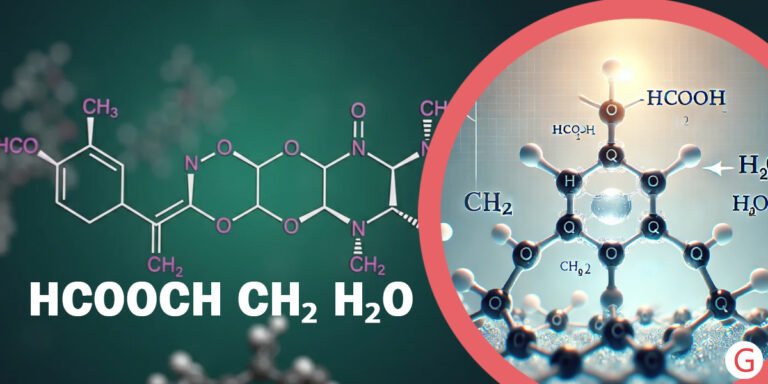The chemical notation HCOOCH CH₂ H₂O might seem complex at first, but breaking it down helps us understand its core structure and purpose. Each part of this compound plays a significant role in its properties and applications.
The HCOOCH segment represents a formate ester, which is derived from formic acid. Esters are commonly used in the fragrance and pharmaceutical industries due to their reactive nature and pleasant aroma.
The CH₂ group refers to a methylene unit, a simple carbon-hydrogen group that acts as a bridge between different molecular components. It plays a role in stabilizing the compound and affecting its reactivity.
Lastly, H₂O, or water, is an integral part of this chemical structure, influencing its solubility, stability, and interactions with other substances.
Molecular Structure and Bonding
The arrangement of HCOOCH CH₂ H₂O gives it unique chemical and physical properties. The formate ester group contains a carbonyl (C=O) bond attached to an oxygen atom, which connects to the methylene group.
This configuration allows the compound to interact with both polar and non-polar molecules, making it useful in various chemical reactions. Additionally, the presence of water in its structure may indicate that it exists in a hydrated form, affecting its stability.
Understanding these molecular interactions is crucial in predicting how the compound behaves in different environments, whether in industrial applications or laboratory settings.

Physical and Chemical Properties
The physical characteristics of HCOOCH CH₂ H₂O determine its usability in different industries.
- Appearance: This compound is usually a colorless liquid with a mild, slightly sweet odor.
- Solubility: It is highly soluble in water and many organic solvents due to its ester and water content.
- Boiling and Melting Points: The boiling point is estimated to be around 100°C, though it may vary slightly based on concentration and environmental conditions.
- Reactivity: The ester group is prone to hydrolysis, meaning it can break down in the presence of water, especially under acidic or basic conditions.
These properties make HCOOCH CH₂ H₂O useful in chemical synthesis, pharmaceuticals, and industrial applications.
How It’s Synthesized
The production of HCOOCH CH₂ H₂O follows a relatively simple esterification process that combines formic acid and an alcohol in the presence of a catalyst.
- Reactants: Formic acid (HCOOH) and an alcohol (such as methanol, CH₃OH) are commonly used as starting materials.
- Catalyst: A strong acid like sulfuric acid (H₂SO₄) speeds up the reaction.
- Reaction Process: The formic acid reacts with the alcohol, producing the formate ester and releasing water.
- Purification: The final product is purified through distillation or filtration, depending on the intended use.
This synthesis method is widely used in industrial chemistry, particularly for producing esters used in perfumes, coatings, and pharmaceuticals.
Common Uses in Industry
Thanks to its versatile chemical nature, HCOOCH CH₂ H₂O finds applications in multiple industries.
- Organic Synthesis: It serves as an intermediate in the production of pharmaceuticals, dyes, and agrochemicals.
- Fragrance and Flavoring: Due to its ester component, it is used in creating artificial flavors and perfumes.
- Industrial Solvent: It acts as a solvent in paint, coatings, and adhesive formulations.
- Pharmaceutical Applications: Some of its derivatives play a role in drug synthesis and medicinal formulations.
Its ability to dissolve both polar and non-polar substances makes it a valuable compound in formulation chemistry.
Environmental and Safety Considerations
While HCOOCH CH₂ H₂O is generally considered low in toxicity, proper handling is essential to prevent any adverse effects.
- Storage Precautions: It should be stored in a cool, dry place away from strong acids, bases, and oxidizing agents.
- Handling Guidelines: Protective gloves, goggles, and ventilation are recommended when working with large quantities.
- Disposal Methods: Waste should be disposed of according to environmental safety regulations to prevent contamination.
Understanding these safety measures ensures that this compound is used efficiently and responsibly in various industries.

Future Research and Innovations
Scientists are exploring new applications for HCOOCH CH₂ H₂O, particularly in green chemistry and sustainable material development.
- Eco-Friendly Solvents: Research is being conducted to develop biodegradable solvents based on ester compounds.
- Advanced Pharmaceutical Uses: Some studies indicate its potential in drug delivery systems and controlled-release formulations.
- Alternative Energy Sources: Certain esters are being tested as biofuel additives for cleaner energy solutions.
These ongoing studies could expand the compound’s role in modern scientific and industrial advancements.
Final Thoughts
The compound HCOOCH CH₂ H₂O is a fascinating example of how chemistry influences multiple industries. With its unique molecular structure, solubility properties, and industrial relevance, it continues to play a vital role in chemical manufacturing, pharmaceuticals, and environmental applications.
As research progresses, we may uncover even more innovative uses for this compound, reinforcing its importance in science and technology.
FAQs
What is HCOOCH CH₂ H₂O used for?
It is used in organic synthesis, pharmaceuticals, fragrances, and as an industrial solvent due to its ester properties and solubility.
Is HCOOCH CH₂ H₂O toxic?
It has low toxicity but should be handled with care, using proper safety measures to avoid irritation or chemical exposure.
How is HCOOCH CH₂ H₂O made?
It is synthesized through esterification, where formic acid reacts with an alcohol, producing an ester and water.
Is HCOOCH CH₂ H₂O water-soluble?
Yes, it is highly soluble in water due to its ester and hydrated molecular structure.
What industries use HCOOCH CH₂ H₂O?
It is widely used in pharmaceuticals, perfumes, coatings, and industrial chemical manufacturing.
Read Also: Zach Bryan’s Real Height: How Tall Is the Country Star?


